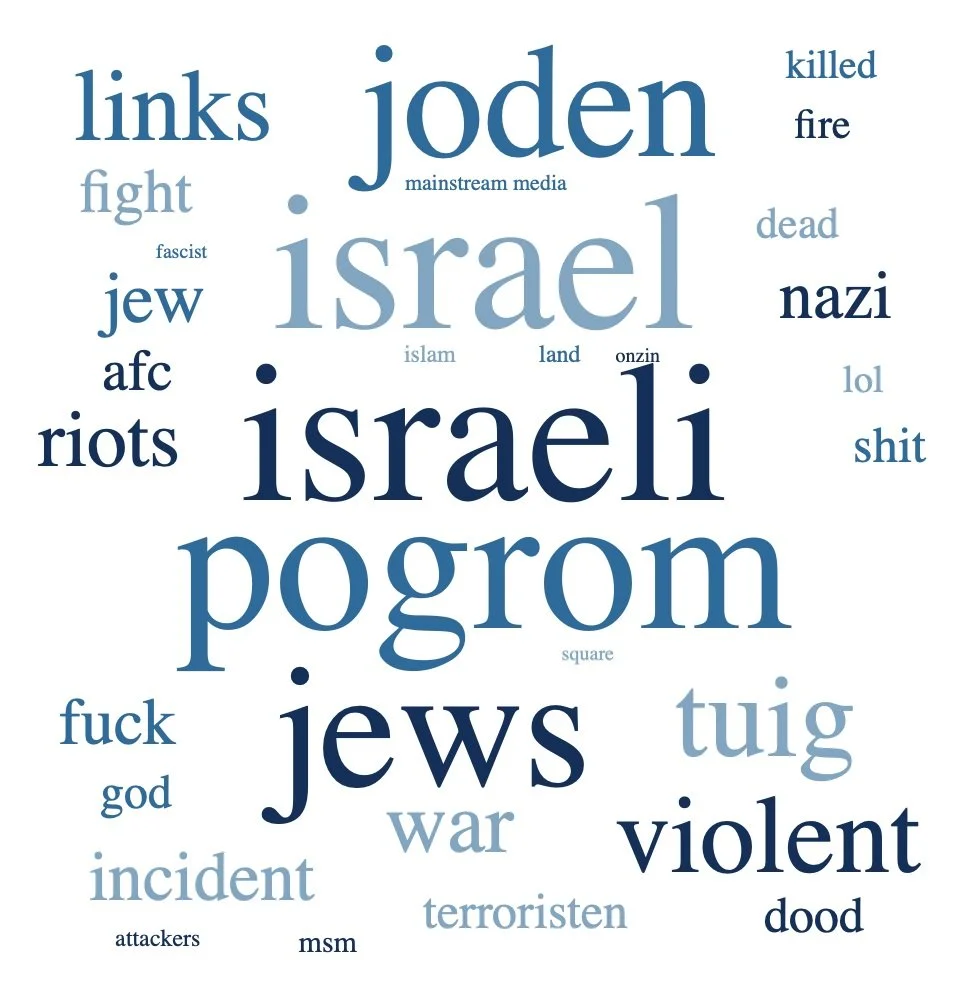The Online Fallout of Amsterdam’s November 8th Violence
Amsterdam became the focal point of an international controversy following a wave on interconnected incidents.
The unrest erupted after a UEFA Europa League football match between Israeli club Maccabi Tel Aviv and Dutch club AFC Ajax, with incidents targeting a local taxi driver, pro-Palestinian protestors, and Israeli fans. These events sparked a polarised global response, resonating across social media and political arenas.
Data for this report was based on 87,685 posts in Dutch and English, across 6 social media platforms: Reddit, X, 4chan, Gab, YouTube, and Facebook.
Content warning: Presented data may contain disturbing language related to online hate speech.
The incident and immediate fallout
On November 7, tensions surrounding the conflict in the Middle East spilled into the streets of Amsterdam as reports emerged of assaults targeting various groups. Clashes left 20–30 people with light injuries, five of whom were hospitalised. At least 71 arrests were made, including 49 Dutch nationals or residents and 10 Israelis.
The violence was fueled by provocations on both sides. Before the match, some Maccabi Tel Aviv fans were filmed pulling Palestinian flags from houses, making anti-Arab chants related to the ongoing conflict in Gaza such as “Death to Arabs,” and “Olé, olé, let the IDF win, we will f*** the Arabs.”, assaulting individuals, and vandalising property. These acts provoked calls for violence against Israeli football supporters on social media, including references to a “Jew hunt.”
After the match, Israeli Maccabi Tel Aviv fans were first seen vandalising parts of the city and attacking Dutch locals, escalating tensions further. This was followed by retaliatory attacks by local youth, where Maccabi fans were ambushed across Amsterdam, with incidents ranging from physical assaults to being shot at with fireworks. The attacks on Israeli fans were widely condemned as criminal and antisemitic.
A toxic cocktail of hate
A report by Amsterdam authorities described the events as “a poisonous cocktail of antisemitism, hooligan behaviour, and anger about the war in Palestine and Israel and other countries in the Middle East.” This analysis highlighted the complex intersection of prejudice, political tensions, and football-related hooliganism.
The framing of the violence as a “pogrom” by some commentators and political figures added fuel to an already volatile situation. Amsterdam Mayor Femke Halsema, who initially used the term, later regretted it, stating that it had been “politicised to the point of propaganda” in both Israel and the Netherlands. Halsema also acknowledged that her characterisation had been used to justify anti-Muslim rhetoric and expressed regret for not being aware of the provocations by some Maccabi Tel Aviv fans before the events unfolded.
The role of social media
Our dashboard tracked 87,685 posts related to the incident between November 7 and November 20, 2024, shedding light on how the narrative evolved online:
November 7: Initial posts about the incidents involving the attack on the taxi driver and pre-match violence and hate garnered limited engagement.
The Night of November 7–8: After midnight, around 01:00 on November 8, the terms “Pogrom” and “Jew Hunt” emerged in online conversations, triggering a significant surge in activity. These words quickly dominated discussions, spreading across platforms and driving high engagement.
November 8: Political figures including Geert Wilders, Joe Biden, Emmanuel Macron, and Justin Trudeau condemned the events as antisemitic. News outlets extensively covered the incidents, with many adopting the frames of “Pogrom” and “Jew Hunt”
Aftermath: Discussions about youth with a Moroccan background being the problem. Some social media users and media outlets begin to question the initial framing of the events.
The online debate quickly turned into a battleground of polarised narratives. Some posts highlighted antisemitism as the root cause of the violence, while others pointed to anti-Muslim sentiment as a contributing factor. Toxic language, including terms such as “scum,” “mocro” (slang for Moroccans), and “alle joden aan het gas” (all Jews to the gas), proliferated across platforms, with fringe platforms like 4chan showing the highest toxicity levels.
Number of posts related to the Amsterdam controversy per day, between 7 November and 20 November.







Examples of posts referring to the Amsterdam protest
Polarised narratives and instrumentalisation of hate
The language and framing used by media outlets and political actors played a critical role in shaping the discourse. Some chose to focus solely on the antisemitic elements of the violence, while others called attention to the broader context, including the violent actions of Maccabi Tel Aviv fans and the rising presence of anti-Muslim rhetoric in the Netherlands
Politicians’ responses amplified these divides, with some leveraging the incident to stoke fears and prejudices against Muslim communities. In the aftermath of the events, the Dutch government framed the violence as an “integration problem,” specifically pointing to youth with a Moroccan background as being disconnected from Dutch values. Calls to revoke the citizenship of dual nationals involved in the violence and deport them intensified the polarised debate. Blame was also directed at “leftists,” including Amsterdam Mayor Femke Halsema, with calls for her resignation circulating online.
The polarisation stemming from the incident reached the highest levels of government on November 15, when a Dutch cabinet crisis was narrowly averted after the resignation of junior minister Nora Achahbar. Achahbar, who was born in Morocco, cited the “polarisation” within the cabinet as making it “impossible” for her to continue in her role.
Wordcloud of the most prominent words related to the Amsterdam protest between November 7 and November 20
Key observations
The incident in Amsterdam underscores the volatile intersection of social, political, and cultural tensions. Key takeaways include:
Both anti-Muslim and antisemitic rhetoric surged, reflecting deep societal divides fuelled by the Middle East conflict.
Media and political actors played a significant role online in amplifying polarisation and hate through their choice of language and framing.
While rectifications and nuanced perspectives, like Halsema’s revised statements, can temper initial reactions, the damage caused by heated words often lingers. Once polarising narratives take hold, they shape public discourse in ways that are difficult to reverse.


